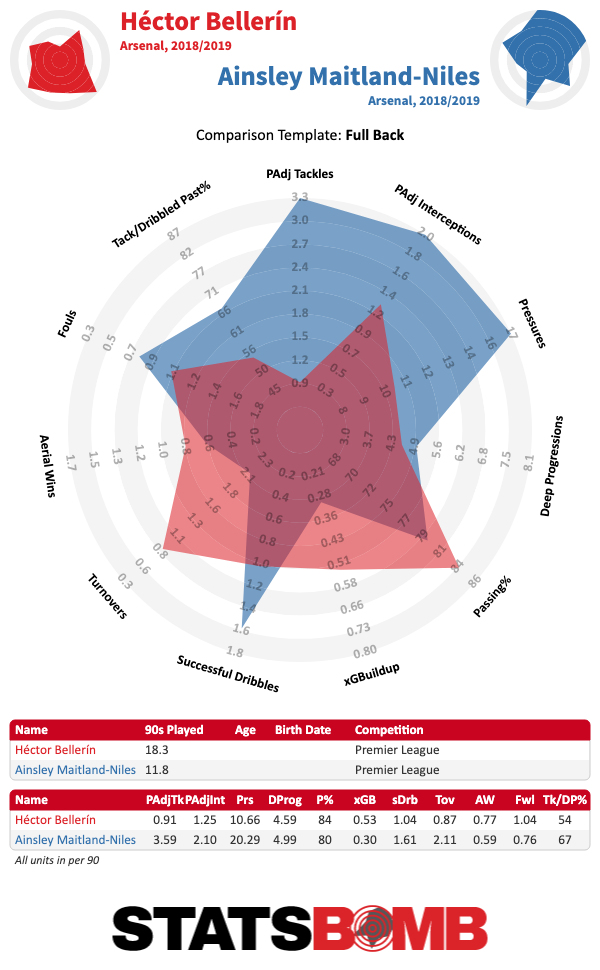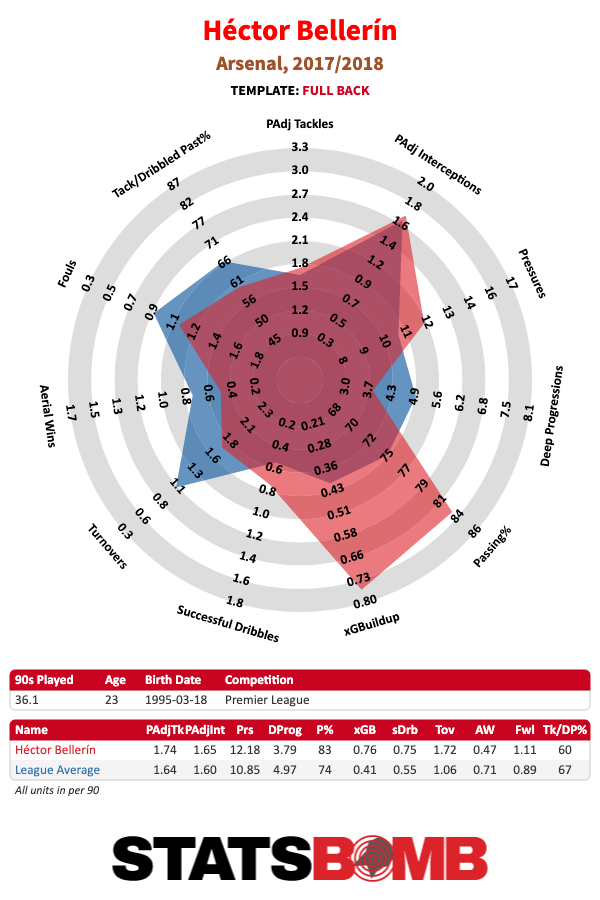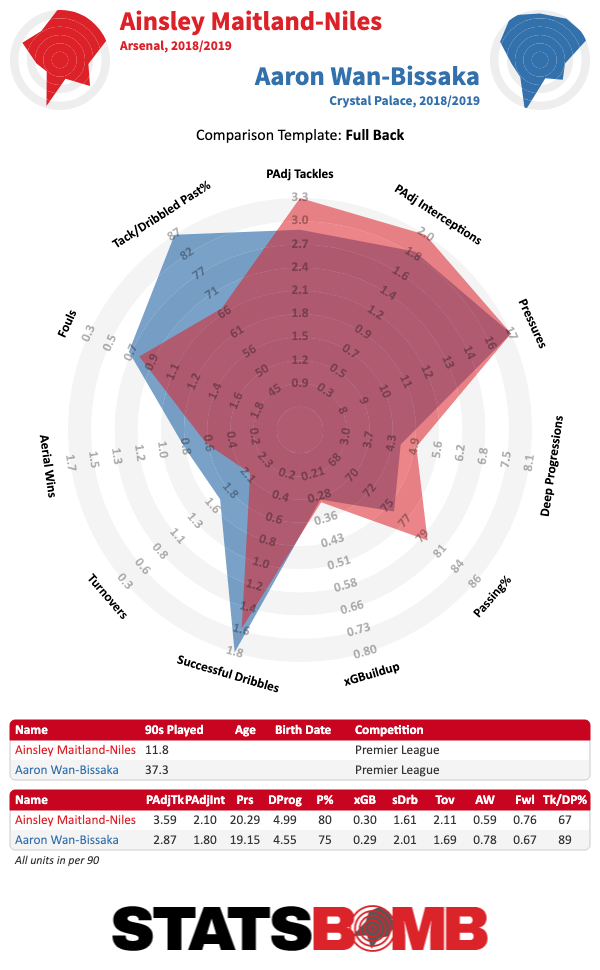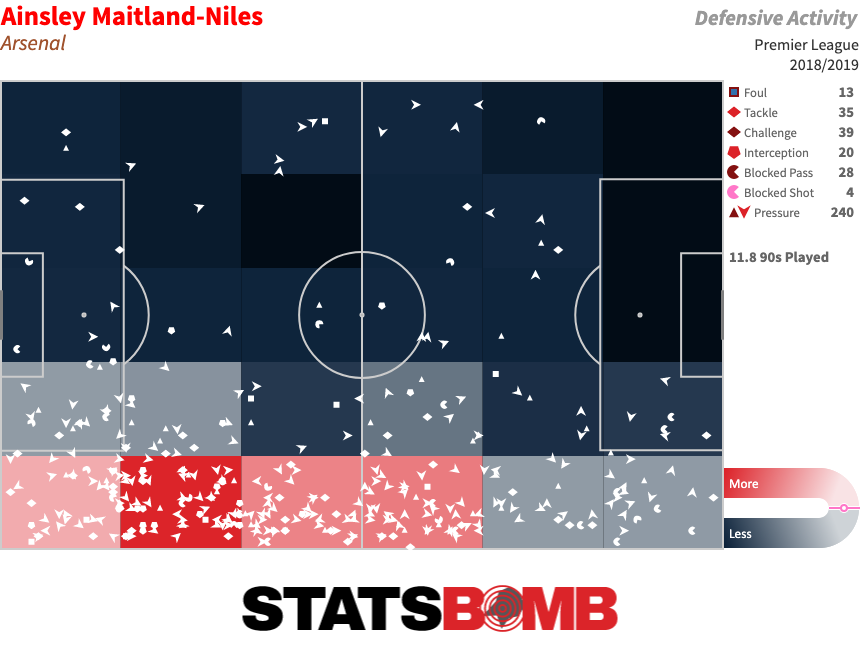There is no right back controversy at Arsenal. Internet boyfriend Héctor Bellerín, who recently returned from a long-term injury, is the starter. Academy product Ainsley Maitland-Niles is once again his backup. This formulation — a starter and his young understudy — flattens the difference between the two players. It suggests that Maitland-Niles is simply a lesser player. While possibly true, that is not a good way to understand either player. Maitland-Niles isn’t a copy of a copy of Bellerín. Arsenal just so happens to have two young, interesting and very different right backs in its squad.  This was not the plan — at least not exactly. The point of Bellerín has never been a mystery: He offers a mix of speed and good passing with just enough defence to justify his presence on the pitch. In Arsène Wenger’s final season, when he was last healthy, Bellerín was a passable defender: his tackles and interception rates were roughly average; he was a decent presser; opposing players dribbled past him a fair bit, which tended to result in him picking up fouls. He didn’t progress the ball so much as he served as an additional creative player higher up the pitch. He passed well enough to make that role work, and was heavily involved in the team’s attack.
This was not the plan — at least not exactly. The point of Bellerín has never been a mystery: He offers a mix of speed and good passing with just enough defence to justify his presence on the pitch. In Arsène Wenger’s final season, when he was last healthy, Bellerín was a passable defender: his tackles and interception rates were roughly average; he was a decent presser; opposing players dribbled past him a fair bit, which tended to result in him picking up fouls. He didn’t progress the ball so much as he served as an additional creative player higher up the pitch. He passed well enough to make that role work, and was heavily involved in the team’s attack.  When Unai Emery took over Arsenal, the club tried to bring in a more defensively-minded backup for Bellerín. This likely reflected the new manager’s preferences. It was also, at least in part, a function of Mathieu Debuchy finally being off the club’s books. Maitland-Niles had filled in during the Frenchman’s tenure, but it was unclear if the club even saw him as a fullback (more on that later). Arsenal needed somebody — anybody, really — to serve as a backup right back. Intelligent people can debate whether Stephan Lichsteiner, signed in the summer of 2018, fit that billing. On the one hand, he had a corporeal presence and had played right (sometimes wing) back. He also had a “winning mentality,” whatever that is. On the other hand, it wasn’t clear his legs actually worked at the time he signed. It quickly became clear, through a combination of injuries and statuesque performances, that even if they had been operational before, those legs certainly didn’t make the trip from England to North London with the rest of him. Maitland-Niles was once again the de facto backup, which might not have mattered all that much if Bellerín’s leg had not also exploded. All of which is to say that Ainsley Maitland-Niles wound up playing more than 2,100 minutes for Arsenal in 2018-19 and was fine, basically. He played nothing like Bellerin, but a team that’s on its third right back can’t really be picky. It also helped that he played like a budget version of Aaron Wan-Bissaka.
When Unai Emery took over Arsenal, the club tried to bring in a more defensively-minded backup for Bellerín. This likely reflected the new manager’s preferences. It was also, at least in part, a function of Mathieu Debuchy finally being off the club’s books. Maitland-Niles had filled in during the Frenchman’s tenure, but it was unclear if the club even saw him as a fullback (more on that later). Arsenal needed somebody — anybody, really — to serve as a backup right back. Intelligent people can debate whether Stephan Lichsteiner, signed in the summer of 2018, fit that billing. On the one hand, he had a corporeal presence and had played right (sometimes wing) back. He also had a “winning mentality,” whatever that is. On the other hand, it wasn’t clear his legs actually worked at the time he signed. It quickly became clear, through a combination of injuries and statuesque performances, that even if they had been operational before, those legs certainly didn’t make the trip from England to North London with the rest of him. Maitland-Niles was once again the de facto backup, which might not have mattered all that much if Bellerín’s leg had not also exploded. All of which is to say that Ainsley Maitland-Niles wound up playing more than 2,100 minutes for Arsenal in 2018-19 and was fine, basically. He played nothing like Bellerin, but a team that’s on its third right back can’t really be picky. It also helped that he played like a budget version of Aaron Wan-Bissaka.  Let’s pause her for a brief digression about Aaron Wan-Bissaka. The comparison with Maitland-Niles is instructive insofar as it shows what Manchester United paid for this summer: A right back who opponents can’t escape on the dribble. The tackles and interceptions and pressures are all nice, but the point of Wan-Bissaka is that you can’t dribble past him. That’s what you pay $60 million for. Still, if you don’t have $60 million to spend and are just fishing around the academy for solutions, as is the late-period Arsenal way, a fullback who does lots of defensive work is a handy find. The high tackle, interception and pressure rates have been a consistent part of Maitland-Niles’ game dating back to Wenger’s final season. (His attacking contribution has been more variable.) He defends slightly deeper than Bellerín, but not in a way that can explain away the substantial difference in outcomes. They’re just different players.
Let’s pause her for a brief digression about Aaron Wan-Bissaka. The comparison with Maitland-Niles is instructive insofar as it shows what Manchester United paid for this summer: A right back who opponents can’t escape on the dribble. The tackles and interceptions and pressures are all nice, but the point of Wan-Bissaka is that you can’t dribble past him. That’s what you pay $60 million for. Still, if you don’t have $60 million to spend and are just fishing around the academy for solutions, as is the late-period Arsenal way, a fullback who does lots of defensive work is a handy find. The high tackle, interception and pressure rates have been a consistent part of Maitland-Niles’ game dating back to Wenger’s final season. (His attacking contribution has been more variable.) He defends slightly deeper than Bellerín, but not in a way that can explain away the substantial difference in outcomes. They’re just different players.  There’s a certain ambiguity to the things Maitland-Niles does well. Some of the tackling, for instance, might be explained away as recovering after opponents dribble past him. Recovering in such situations is good, but it doesn’t always inspire confidence. It’s easy to overstate the extent of the concern here. Opponents have dribbled past Maitland-Niles at a league-average rate in each of the last two seasons. He’s not Wan-Bissaka, obviously, but he does not have a history of getting roasted on the dribble. (So far this year, in a small sample, he’s been well below average.) Sometimes a tackle is just a tackle. Imagine a player who has played more than 2,100 minutes in consecutive seasons before his 22nd birthday. He’s a league-average defender against opposing players on the dribble but elite when it comes to pressing, tackling and intercepting. He’s a good dribbler, but doesn’t contribute much else in attack. Would you dispute that he’s a fullback? Would you dispute that he is of value? Such is the case with Ainsley Maitland-Niles, who some Arsenologists still insist is a defensive midfielder filling in at fullback in the club’s frequent times of crisis. (Some reporting suggests Maitland-Niles also feels this way.) About which, maybe??? Players can move between being defensive midfielders and fullbacks. That may be the biggest tactical legacy of Pep Guardiola’s Bayern Munich. But football is also rife with fullbacks who began their careers as midfielders. Maitland-Niles might one day be a midfielder, but it seems clear enough that he is already an interesting defensive fullback. This leaves Arsenal in an interesting position. There is no fullback competition. Bellerín is the starter when healthy, and Maitland-Niles’ defensive performances have done little to solidify the team in his absence. He is nevertheless an interesting piece, and definitely more than a squad player to be called upon in emergencies. Arsenal set out to get a defensive backup for Bellerín in 2018 only to find him already within the squad. What would be more Arsenal than lucking into such a player only to have no plan for using him?
There’s a certain ambiguity to the things Maitland-Niles does well. Some of the tackling, for instance, might be explained away as recovering after opponents dribble past him. Recovering in such situations is good, but it doesn’t always inspire confidence. It’s easy to overstate the extent of the concern here. Opponents have dribbled past Maitland-Niles at a league-average rate in each of the last two seasons. He’s not Wan-Bissaka, obviously, but he does not have a history of getting roasted on the dribble. (So far this year, in a small sample, he’s been well below average.) Sometimes a tackle is just a tackle. Imagine a player who has played more than 2,100 minutes in consecutive seasons before his 22nd birthday. He’s a league-average defender against opposing players on the dribble but elite when it comes to pressing, tackling and intercepting. He’s a good dribbler, but doesn’t contribute much else in attack. Would you dispute that he’s a fullback? Would you dispute that he is of value? Such is the case with Ainsley Maitland-Niles, who some Arsenologists still insist is a defensive midfielder filling in at fullback in the club’s frequent times of crisis. (Some reporting suggests Maitland-Niles also feels this way.) About which, maybe??? Players can move between being defensive midfielders and fullbacks. That may be the biggest tactical legacy of Pep Guardiola’s Bayern Munich. But football is also rife with fullbacks who began their careers as midfielders. Maitland-Niles might one day be a midfielder, but it seems clear enough that he is already an interesting defensive fullback. This leaves Arsenal in an interesting position. There is no fullback competition. Bellerín is the starter when healthy, and Maitland-Niles’ defensive performances have done little to solidify the team in his absence. He is nevertheless an interesting piece, and definitely more than a squad player to be called upon in emergencies. Arsenal set out to get a defensive backup for Bellerín in 2018 only to find him already within the squad. What would be more Arsenal than lucking into such a player only to have no plan for using him?
2019
I’ll be right back: The Héctor Bellerín and Ainsley Maitland-Niles Arsenal story
By admin
|
October 15, 2019